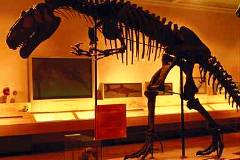13 May 1999
Foot-Movement Similarity In Dinosaurs And Birds Shown by Fossil Footprints
 Research examining theropod dinosaur prints has found that foot motions were preserved in three dimensions when the meat eaters slopped through mud 210 million years ago. And while there are significant differences in the position of the big toe, foot posture and hind limb movement, the footprints show similarities with those made by modern day birds.
Research examining theropod dinosaur prints has found that foot motions were preserved in three dimensions when the meat eaters slopped through mud 210 million years ago. And while there are significant differences in the position of the big toe, foot posture and hind limb movement, the footprints show similarities with those made by modern day birds.
"Living birds retain many features from their theropod ancestors, but hind limb anatomy and function did change," said lead scientist Stephen Gatesy, assistant professor of ecology and evolutionary biology at Brown University. "Birds do not move exactly like 210-million-year-old dinosaurs, but they are the closest thing alive today."
Gatesy and colleagues discovered and studied numerous trackways made by human-sized theropod dinosaurs that strode on hind legs across extensive mud flats in what is now Greenland. At the time the dinosaurs roamed, the region was more tropical than arctic.
On firm ground, a theropod's foot produced shallow, three-toed impressions.
On sloppier muds, the foot sank deeper and left behind unusually long, four-toed prints. Such deep tracks captured movements of the foot below the surface, preserving a three-dimensional record of locomotor behavior in Triassic-period dinosaurs.
The researchers said that a spectrum of tracks similar to the Greenlandic series is produced when a bird walks through mud of various consistencies. In the tracks of both Triassic theropods and living birds, the foot plunged down and forward into the muck. The toes collapsed together below the surface as the entire foot emerged at the front of the track.
Gatsey and his colleagues checked the comparison by running a modern turkey through sloppy mud and examining its tracks.
"It's clear that the deep prints were made by similar mechanisms," said Gatesy. "The possibility that a dinosaur's toes could enter and exit the sediment in different places had never been considered until we saw the turkey do it."
Although the Greenlandic prints closely match those made by modern-day ground-dwelling birds, there are important differences, said the researchers. The first toe (our "big" toe) is reversed in most birds, allowing the foot to perch or grasp prey. Deep Triassic prints bear an impression of the first toe that points backwards, leading some scientists to speculate that ancient theropods with a perching foot were present, yet undiscovered. However, Gatesy and colleagues determined that the first toe's backward pointing imprint was an artifact of foot motion, not a true indicator of its orientation.
The tracks also give clues to differences in hind limb movement. In sloppy mud, Greenlandic theropods left imprints of the soles of their feet. This indicates that the limb moved about the hip, as in alligators. In contrast, walking birds primarily move by bending their knees, which raises the sole of the foot before it can leave a print.
Although the study found both similarities and differences between modern fowl and ancient theropods, the researchers believe that birds did evolve from dinosaurs.
"The Greenlandic trackways show that toe convergence was present very early in theropod evolution and inherited by birds," said researcher Kevin Middleton, a Brown graduate student. "An opposable first toe did not evolve until later."
The study will be published in the journal Nature.
